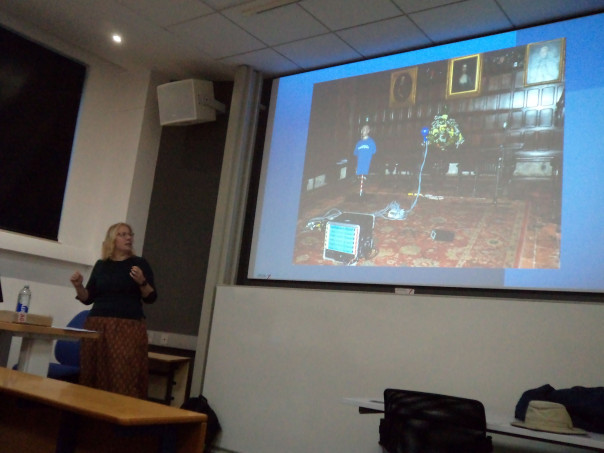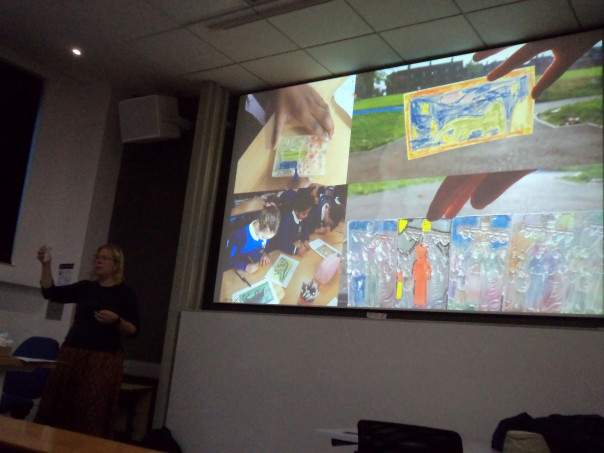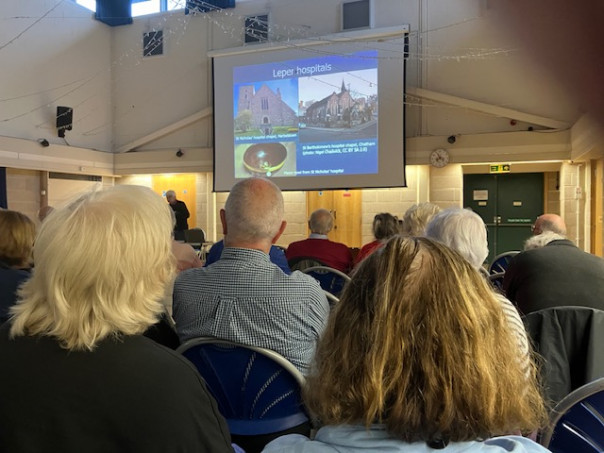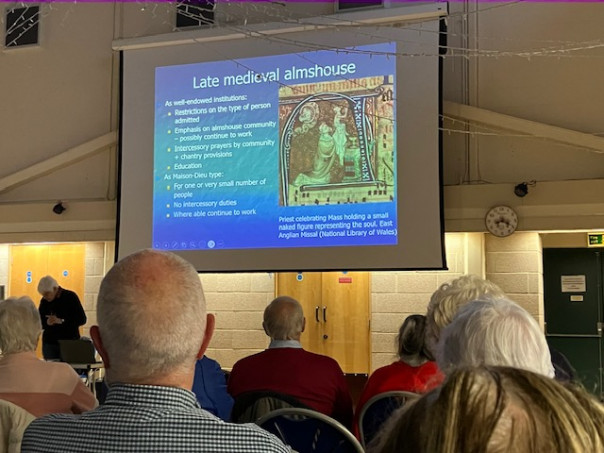This week is more some short reports on people’s activities around the county rather than notices of what’s coming up next week. However, looking slightly further into June, I thought I would just mention three forthcoming events.
The first of these is the official opening ceremony of the new archaeology gallery at Maidstone Museum entitled ‘Lives in our Landscape’ on Tuesday 4 June. Some readers may remember I featured some of the medieval artefacts in the blog last year when I was working on the medieval section for the museum, while similarly Dr Andrew Richardson was working on the Anglo-Saxon artefacts. It will be very exciting to see the finished gallery.
Then the week after there will be two further events involving CKHH. The first on Wednesday 12 June will be Lizzie Burton’s presentation to the Kent History Postgraduates on her research investigating emotions concerning the poor during the period 1600 and 1800, and how they coped with poverty. Her doctoral research project sounds fascinating, so it will be excellent to see this. Later that week, detailed programme awaited, the MEMSFest at the University of Kent will include a panel of Kieron Hoyle, Jason Mazzocchi and Kaye Sowden which is exciting because these conferences have been excellent in the past.

As a starting point, just a quick mention to say that the Lossenham Project wills group will be meeting online tomorrow (Thursday) and this community history research group includes staff and postgraduates from CKHH. The group members continue to be busy transcribing probate materials for the project’s database, and in July we are intending to visit the exhibition at Tenterden Museum that features some of the group’s findings.
Going back to last Thursday, Dr Catriona Cooper gave a lecture in the joint CKHH/FCAT lecture series. This had had to be postponed because of the bad weather in the winter so it was great to be able to see how she had employed digital approaches to explore the sensorial experience of a wide range of different spaces, especially visually and aurally. By way of introducing her topic, Dr Cooper demonstrated the various techniques that have been developed to measure matters relating to sound in different places and how these can be interpreted to offer ideas about how individuals and groups navigate and understand the spaces they inhabit. She also acknowledged that while such modelling of places is good and getting better, there remains a gap between interpretation in this way and the actual lived experience in the past.

Her first two cases involved work from her doctoral studies on Bodiam Castle and Ightham Mote, both fascinating sites. For as well as the still ongoing debate regarding the motives for building later castles – military, prestige, as a political statement, as Catriona said, the castle’s complex interior remains challenging to analyse concerning use and understanding of how the spaces would have been experienced by contemporaries. Until very recently, most depictions of historic places relied on plans, but this is beginning to change as 3-D modelling has become more common. Furthermore, to this there has been an increasing desire to explore how rooms may have been decorated and furnished and the implications of such materials as wall coverings, whether we are discussing wainscoting, painted clothes, tapestries etc, as well as the implications of fires – as open hearths, as fireplaces with chimneys. In addition, there is the role of candlelight and how this affected how people negotiated and understood their surroundings.
Having similarly discussed how it is becoming more viable to research the sensory experience of Ightham Mote in terms of lived and bodily experience, as well as taking into account that it is important to avoid a romanticised view of these spaces, but instead to explore how sound moved around and between them, Dr Cooper drew on her third case study. For that we moved to the listening experience of the House of Commons in the 19th century, specifically those, especially women who had listened from the ‘ventilator’. This project, too, sounds fascinating and as well as exploring how MPs listen and aim to use the acoustics of the chamber to best advantage, it was most interesting to get a taste of what it must have been like trying to decipher the voices etc for the women in the ventilator.
Moving to feel and touch, Dr Cooper’s final case study involved how museums can make best use of 3-D printing as a means to engage different audiences. Surface properties of materials are, therefore, extremely significant and the desire to touch and handle objects seems to be extremely important in order to engage with their materiality. Dr Cooper’s lecture sparked a barrage of questions from her keen audience, who were fascinated by this very different methodological approach, and it was, therefore, an upbeat way to finish this lecture session.

In some ways, although the subject matter was different, the workshop the following day at the University of Kent on ‘Finding Vikings in Kent’ was equally intriguing. This workshop, led by Dr Heidi Stoner (Archaeology, CCCU) and Dr Robert Gallagher (History, Kent University) brought together leading experts in Viking Studies, such as Professors Judith Jesch and Clare Downham, and Dr Jane Kershaw, as well as academics from beyond Canterbury and representatives from archaeological units and from heritage organisations. Like many such workshops, the discussions during the breaks were probably as fruitful as the formal sessions and for the organisers, hopefully it was a highly productive couple of days as they seek to move forward towards a research project application to the AHRC.
Then on Saturday, to mark the 80th Anniversary of D-Day in June, Peter Joyce, an ex-serviceman and member of the Kent History Postgraduates, was one of those invited to attend when the Commonwealth War Graves Commission’s (CWGC) torch of commemoration appeared at Chatham Naval Memorial. As the spokesperson from the CWGC reported, this ceremony is designed to engage younger people and inspire them to play their part in marking the sacrifices of the fallen and to understand the lessons of the Second World War.
The final two events I want to highlight this week took place yesterday (Tuesday). The first in the afternoon was the History Student Research Day which was led by Dr John Bulaitis, convenor of the Taught Modern History MA at CCCU. Just as at MEMS at Kent (see above), the idea was for members of the MA cohort at CCCU to give presentations on their dissertation topic, getting feedback from their student peers and from staff, including supervisors. Furthermore, a couple of final year dissertation BA students also gave presentations, there was a MA by Research student presentation, and the afternoon concluded with a fascinating guest lecture by Professor Karen Harvey (University of Birmingham), who spoke on ‘Reliquary Power and Textual Embodiment: The Body and Letters in Britain, 1680–1820’.

The topics discussed by the students covered a wide range of topics, ranging from explorations about the recent history of Pakistan to how disability was portrayed in films in the 1930s. However, for the purposes here, I’ll just say a little about 3 on Kent history topics and I’ll work chronologically. For his project, Ephraim George will be examining the ecclesiastical and ideological significance of Canterbury from the penultimate Anglo-Saxon king to the time of Archbishop Becket. During his presentation, Ephraim discussed the works of the principal historians he will be using and the textual primary sources he sees as crucial to this project.
The next of these Kent history presentations was given by Josh Obbard, who is exploring what he sees as the changing identities of Margate between 1750 (the founding of the sea-bathing hospital) and the present day. Having divided this period into five eras: sea-bathing, railway, entertainment, decline, redevelopment, he will discuss these different identities in the first part of his dissertation before moving to his study based on questionnaires to be collected from visitors and residents in Margate this summer.
Katie Williams took us to the Maison Dieu at Dover. As part of her MA placement module, she has been working with Martin Crowther, the restoration and conservation project lead there, as well as with Dr Diane Heath (Medieval Animals Heritage) and Kieron Hoyle, who is researching the role of the Maison Dieu in the developing Tudor Dover harbour works. Having enjoyed her time there so much, Katie wants to extend her research through her dissertation by investigating the role and influence of William Burges, who was far more than an architect!, on the Maison Dieu as a civic building and its and his cultural impact. This two-way process will provide her with ideas regarding the debates taking place in the 19th century, as well as emotional responses then and now to such neo-Gothic buildings, fixtures and fittings.

In some ways going back to the original Gothic, the final report for this week concerns a lecture I gave to St Margaret-at-Cliffe History Society that evening, the invitation having come about because Carol Partridge had attended the ‘Working with Wills’ workshops at St Mary’s church, Dover last summer. For this presentation they had asked for ‘Medieval Hospitals in Kent’, and because this is quite a long blog already, I’ll keep this short. However, you cannot start such a topic without looking at the Seven Corporal Works of Mercy and a wall painting of the Last Judgment! Moving on from there, we looked briefly at the 4 types of hospital, primarily based on those accommodated, albeit hospitals changed over time and might house more than one of these groups.
Having got a grasp of the hospital foundation chronology in broad terms, the total number in Kent during the Middle Ages and the distribution pattern across the county, I then worked through the different hospital types, beginning with the leper hospitals to explore when they were founded, who were the founders, their size and who was accommodated, were they well supported or not, did they have a chapel and the nature of the patrons. As a result, I drew on examples from Otford, Rochester and Chatham in the west and north to the three leper hospitals close to Canterbury and then to those in the Cinque Ports.
Doing a similar thing for the hospitals for the poor and infirm, I followed the same format using examples such as St John’s hospital at Canterbury, St Bartholomew’s hospital at Sandwich, St Peter and St Paul’s hospital at Maidstone and Holy Cross hospital at Swainestrey. Then for the pilgrim hospitals, the examples were divided by size of hospital. The small hospitals were the one at Shooter’s Hill, St Thomas’ hospital at Sittingbourne and St John’s hospital at Blean. Even though little is known about the small hospitals, I could offer much more information about the medium and large pilgrim hospitals, the former being St Mary’s hospital at Strood and St Thomas’ hospital at Canterbury, the latter being the Maison Dieu hospitals at Ospringe and Dover.

The fourth group of hospitals was the late medieval almshouse which came in two forms, the well-endowed institutions and the maison-dieu type (as based on Dr Patricia Cullum’s idea). Although Kent didn’t have any of the former of the scale of Ewelme, it did have some, including the Corpus Christi almshouse at Maidstone as part of the fraternity there. Furthermore, there were probably far more of the latter, being ephemeral institutions, than have yet been identified.
This brought me to my final section on the late medieval adjustments of the older hospitals to give an idea of how the county’s hospitals had changed. Without going into this much further, these included the admittance of corrodians, greater emphasis on spiritual provisions including chantries, a move away from communal living but the idea of working as a community for the common good. Among the hospitals that provided helpful examples, I cited St Bartholomew’s at Sandwich, St John’s at Canterbury and St Nicholas’s at Harbledown. This brought questions from the audience, including matters relating to lepers and pilgrims, the former extended to lepers in early modern Scandinavia and with the re-opening of the Maison Dieu at Dover next year, hopefully some will be keen to visit that fascinating medieval hospital at its core.
 Centre for Kent History and Heritage
Centre for Kent History and Heritage Sheila Sweetinburgh
Sheila Sweetinburgh 1628
1628


